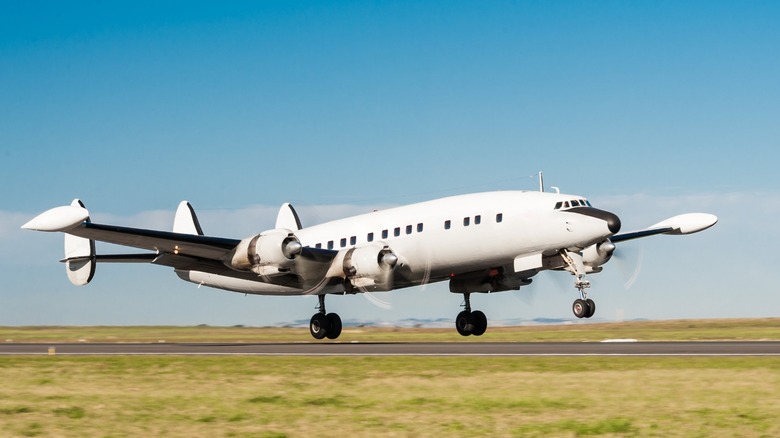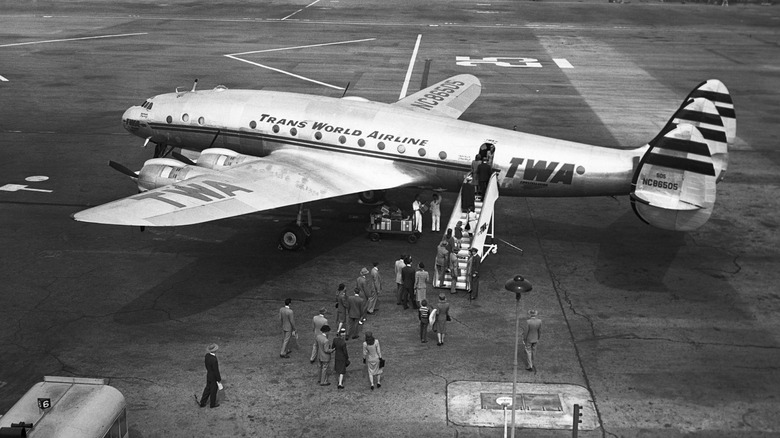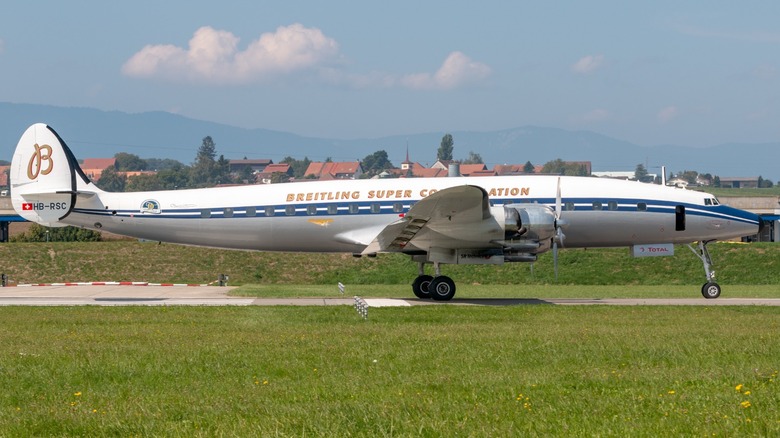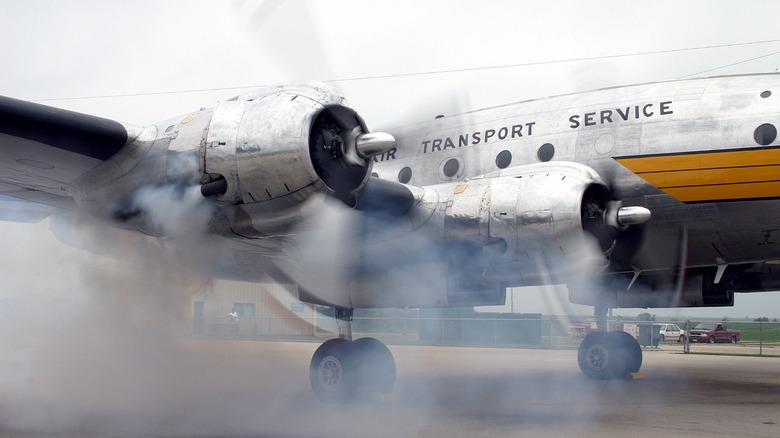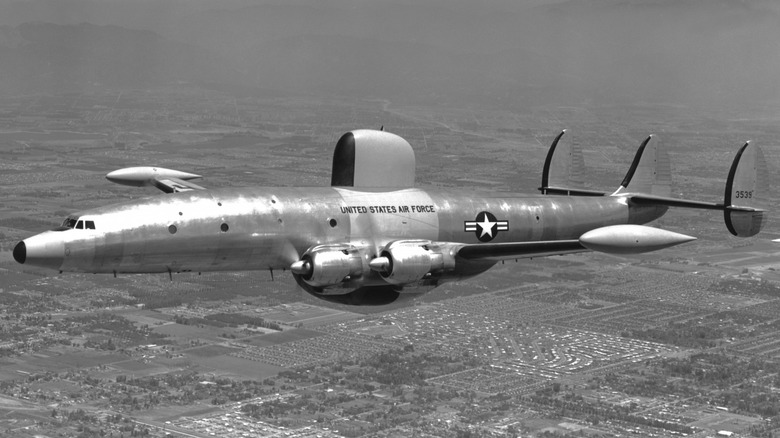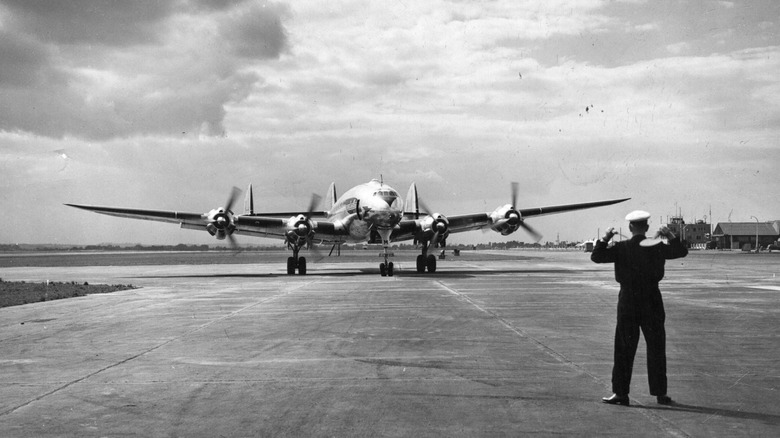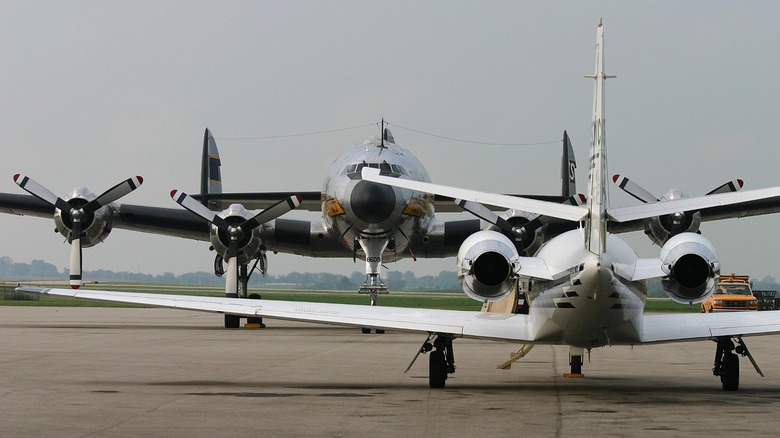What Made The Lockheed Constellation Such A Unique Development For Aviation
When discussing iconic airplanes from aviation history, most people think about aircraft like the gigantic Boeing 747, the legendary P-51 Mustang, the supersonic SR-71 Blackbird, or the stealthy F-35 Lightning II. However, aside from the 747, these fast and sleek airplanes are military aircraft, meaning that most of us won't ever get to see them, much less ride in them.
Aside from planes like the 747 or the Concorde, many civilian airliners are overlooked because they aren't that flashy or groundbreaking. However, what people often don't consider is that it's these jet airliners that enable people all over the world to hop on a plane to get to the other side of the world in less than a day.
Before jet airliners became the norm, the world was flying on piston aircraft like the Lockheed Constellation — sometimes affectionately called "Connie" by enthusiasts. At its peak, this propeller airliner was considered one of the best commercial passenger planes. So, let's look back at this famous piston-engined airplane and see how it influenced the planes we fly today.
A popular pressurized airliner
All modern airliners are pressurized at 8,000 feet, allowing their passengers to breathe and feel comfortable even if they fly at 30,000 feet or higher. While we take this for granted today, it wasn't the norm until the Lockheed Constellation made this technology popular for the flying public.
Pressurization allows aircraft to fly above 10,000 to 15,000 feet without requiring oxygen for each passenger. At these altitudes, the airplane will fly above most weather, making the trip safer and more comfortable. Although Boeing introduced the first pressurized airliner in 1940 with the Boeing 307 Stratoliner, the Lockheed Constellation popularized it after World War II.
That's because Boeing only made 10 307s, while Lockheed built and sold well over 800 Constellations. Since airlines like TWA, Pan Am, BOAC, and Air France operated the Constellation on popular routes like New York to Paris and Bermuda to New York, more people had their first commercial flight aboard the Connie.
A unique shape and profile
In addition to its use of cabin pressurization, the Lockheed Constellation stood out from its peers because of its shape. Unlike its contemporaries, which featured a cylindrical cigar fuselage and usually a single large tail, the Connie had a unique dolphin-like body and three smaller tails at the rear empennage.
Lockheed used the triple fin tail design over a larger single-piece tail to ensure the large airliner would fit in existing hangars. It also featured modern features (for the 1940s) like de-icing systems and hydraulic controls, allowing it to fly even in inclement weather. The Connie used durable tricycle landing gear capable of carrying a heavier payload and was raised higher off the ground than other planes.
The Lockheed Constellation had four radial engines, rather than other two- and three-engined airplanes popular at the time. Lockheed also made several variants of the Constellation, with the smallest capable of sitting 60 passengers and the largest model having a maximum capacity of over 100 people.
As fast as a fighter
One of the Lockheed Constellation's biggest advantages is its speed. Although its first model had a top speed of just 313 mph, its later models reached 377 mph, making it faster than its contemporaries, such as the Douglas DC-6B, which topped out at around 315 mph. This top speed made some variants faster than some popular World War II fighters, like the Japanese Zero (350 mph). This was a feat for Lockheed, especially as it's much larger than these flying fighting machines.
The base variant Constellation L-049 can carry more than 36,000 pounds or more than 18 tons. This speed and capacity made the Constellation a good candidate for military service, even though it was initially designed as a civilian airliner. Although the TWA was the first to order the Constellation in 1940, the US Army Air Forces (USAAF) took over this order when the U.S. entered World War II, as the plane would go on to aid American forces.
The Connie has a unique place in American history
The Connie is more than just a passenger plane. In fact, it also had a storied military career, especially as it made its first flight right in 1943 — right in the middle of the Second World War — where it served as a long-range fast transport aircraft for the US military as the C-69.
Its service continued after the war, when, between 1948 and 1955, the newly-founded US Air Force ordered 150 L-749 variants, giving it the C-121A designation. Because of the large capacity of the Connie, they were indirectly involved in the Berlin Airlift. But since they were too large for the runways at Berlin's airports, only smaller aircraft like the DC-3 flew directly to the city. Instead, the Connie's large size was instrumental in flying essential cargo from the US to England or West Germany before being flown into Berlin.
Some of these aircraft were eventually converted into VIP transport aircraft, with one assigned to General Douglas MacArthur as his personal transport during the Korean War. Two Lockheed Constellations were also converted for presidential use by Eisenhower. They were given the names Columbine II and Columbine III, with the designation VC-121A-LO, and were the first aircraft to be given the Air Force One callsign when the US president was on board.
The last piston airliner
After World War II, the Constellation finally flew for its original operator, TWA, which used it for the lucrative transatlantic route. It wasn't the first aircraft to fly this route, as flying boats used to do this years before. However, the construction of several long runways in Europe and the U.S. for the war effort made long-distance land-based aircraft flight more viable, thus allowing aircraft like the Connie to become more prevalent.
TWA, the airline that made the initial order for the Connies, started operating it in 1946 between New York and Paris. Soon after, Pan Am launched the round-the-world Pan Am Flight 001 with the L-049. Eventually, other airlines bought the aircraft, including Air France, KLM, Qantas, Lufthansa, and more.
But even though the Constellation was a great airliner, the advent of the jet-engine age meant it wouldn't stay on top for long as a piston airliner. The Lockheed airliner was a propeller-driven aircraft powered by piston engines, which meant that it was slower, less efficient, and not as comfortable as the newer jet-powered planes coming into the market.
The end of an era in airline travel
De Havilland introduced the Comet, the first jet-powered airliner in the world, in 1952. It was powered by four jet engines, which gave it a cruising speed of 460 mph. Although it was grounded in 1954 due to a series of crashes, it wasn't long until Boeing's first jetliner, the 707, and the competing DC-8 arrived just four years later in 1958.
The popularity of jet travel would eventually seal the fate of the Lockheed Constellation. 10 years after the 707s and DC-8s entered service, the Connie made its last scheduled passenger flight in North America in 1968.
The Connie flew for over 20 years across the globe and was one of the pioneers of international air travel. Although it was eventually eclipsed by jet aircraft, we cannot deny that some of the things we expect from modern airliners were made famous by the Lockheed Constellation.
